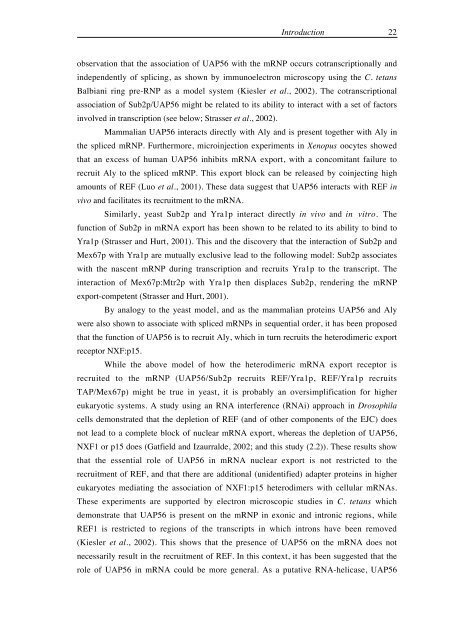The role of human and Drosophila NXF proteins in nuclear mRNA ...
The role of human and Drosophila NXF proteins in nuclear mRNA ...
The role of human and Drosophila NXF proteins in nuclear mRNA ...
You also want an ePaper? Increase the reach of your titles
YUMPU automatically turns print PDFs into web optimized ePapers that Google loves.
Introduction 22<br />
observation that the association <strong>of</strong> UAP56 with the mRNP occurs cotranscriptionally <strong>and</strong><br />
<strong>in</strong>dependently <strong>of</strong> splic<strong>in</strong>g, as shown by immunoelectron microscopy us<strong>in</strong>g the C. tetans<br />
Balbiani r<strong>in</strong>g pre-RNP as a model system (Kiesler et al., 2002). <strong>The</strong> cotranscriptional<br />
association <strong>of</strong> Sub2p/UAP56 might be related to its ability to <strong>in</strong>teract with a set <strong>of</strong> factors<br />
<strong>in</strong>volved <strong>in</strong> transcription (see below; Strasser et al., 2002).<br />
Mammalian UAP56 <strong>in</strong>teracts directly with Aly <strong>and</strong> is present together with Aly <strong>in</strong><br />
the spliced mRNP. Furthermore, micro<strong>in</strong>jection experiments <strong>in</strong> Xenopus oocytes showed<br />
that an excess <strong>of</strong> <strong>human</strong> UAP56 <strong>in</strong>hibits <strong>mRNA</strong> export, with a concomitant failure to<br />
recruit Aly to the spliced mRNP. This export block can be released by co<strong>in</strong>ject<strong>in</strong>g high<br />
amounts <strong>of</strong> REF (Luo et al., 2001). <strong>The</strong>se data suggest that UAP56 <strong>in</strong>teracts with REF <strong>in</strong><br />
vivo <strong>and</strong> facilitates its recruitment to the <strong>mRNA</strong>.<br />
Similarly, yeast Sub2p <strong>and</strong> Yra1p <strong>in</strong>teract directly <strong>in</strong> vivo <strong>and</strong> <strong>in</strong> vitro. <strong>The</strong><br />
function <strong>of</strong> Sub2p <strong>in</strong> <strong>mRNA</strong> export has been shown to be related to its ability to b<strong>in</strong>d to<br />
Yra1p (Strasser <strong>and</strong> Hurt, 2001). This <strong>and</strong> the discovery that the <strong>in</strong>teraction <strong>of</strong> Sub2p <strong>and</strong><br />
Mex67p with Yra1p are mutually exclusive lead to the follow<strong>in</strong>g model: Sub2p associates<br />
with the nascent mRNP dur<strong>in</strong>g transcription <strong>and</strong> recruits Yra1p to the transcript. <strong>The</strong><br />
<strong>in</strong>teraction <strong>of</strong> Mex67p:Mtr2p with Yra1p then displaces Sub2p, render<strong>in</strong>g the mRNP<br />
export-competent (Strasser <strong>and</strong> Hurt, 2001).<br />
By analogy to the yeast model, <strong>and</strong> as the mammalian <strong>prote<strong>in</strong>s</strong> UAP56 <strong>and</strong> Aly<br />
were also shown to associate with spliced mRNPs <strong>in</strong> sequential order, it has been proposed<br />
that the function <strong>of</strong> UAP56 is to recruit Aly, which <strong>in</strong> turn recruits the heterodimeric export<br />
receptor <strong>NXF</strong>:p15.<br />
While the above model <strong>of</strong> how the heterodimeric <strong>mRNA</strong> export receptor is<br />
recruited to the mRNP (UAP56/Sub2p recruits REF/Yra1p, REF/Yra1p recruits<br />
TAP/Mex67p) might be true <strong>in</strong> yeast, it is probably an oversimplification for higher<br />
eukaryotic systems. A study us<strong>in</strong>g an RNA <strong>in</strong>terference (RNAi) approach <strong>in</strong> <strong>Drosophila</strong><br />
cells demonstrated that the depletion <strong>of</strong> REF (<strong>and</strong> <strong>of</strong> other components <strong>of</strong> the EJC) does<br />
not lead to a complete block <strong>of</strong> <strong>nuclear</strong> <strong>mRNA</strong> export, whereas the depletion <strong>of</strong> UAP56,<br />
<strong>NXF</strong>1 or p15 does (Gatfield <strong>and</strong> Izaurralde, 2002; <strong>and</strong> this study (2.2)). <strong>The</strong>se results show<br />
that the essential <strong>role</strong> <strong>of</strong> UAP56 <strong>in</strong> <strong>mRNA</strong> <strong>nuclear</strong> export is not restricted to the<br />
recruitment <strong>of</strong> REF, <strong>and</strong> that there are additional (unidentified) adapter <strong>prote<strong>in</strong>s</strong> <strong>in</strong> higher<br />
eukaryotes mediat<strong>in</strong>g the association <strong>of</strong> <strong>NXF</strong>1:p15 heterodimers with cellular <strong>mRNA</strong>s.<br />
<strong>The</strong>se experiments are supported by electron microscopic studies <strong>in</strong> C. tetans which<br />
demonstrate that UAP56 is present on the mRNP <strong>in</strong> exonic <strong>and</strong> <strong>in</strong>tronic regions, while<br />
REF1 is restricted to regions <strong>of</strong> the transcripts <strong>in</strong> which <strong>in</strong>trons have been removed<br />
(Kiesler et al., 2002). This shows that the presence <strong>of</strong> UAP56 on the <strong>mRNA</strong> does not<br />
necessarily result <strong>in</strong> the recruitment <strong>of</strong> REF. In this context, it has been suggested that the<br />
<strong>role</strong> <strong>of</strong> UAP56 <strong>in</strong> <strong>mRNA</strong> could be more general. As a putative RNA-helicase, UAP56

















